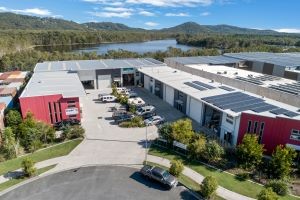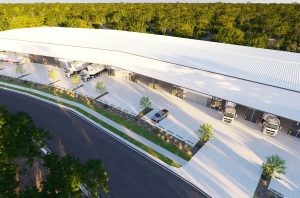Meet Tallon Pamenter: A Rising Star in Sunshine Coast Commercial Property
The RWC Noosa & Sunshine Coast commercial property consultant is known for developing strong relationships and outcomes that benefit all parties.
Industrial property on the Sunshine Coast remains a steady performer despite backing off from a 2022 peak. Demand continues to outstrip supply while fluctuating market conditions and the cost of finance have temporarily stalled the developers in this asset class.
As investors watch and wait, gauging the impact of higher interest rates and economic unpredictability, owner occupiers are making their move and breaking away from the rental cycle.
“Interest rate rises have made the market more sensible and slowed things down a little but good businesses are still doing business. The market has gone from a developer/speculator scenario back to actual businesses relocating, upsizing, downsizing, whatever general requirements they have,” explains Paul Butler, RWC Sunshine Coast & Noosa Principal.
“Industrial properties are still being transacted quickly. However, overall the market’s not quite in sync, with some disconnect remaining between vendors and buyers. Properties priced 5-10% over where the market is sitting are requiring more time on market to achieve a result.”
These trends are fairly consistent with what’s happening nationally, although the Sunshine Coast industrial market seems to have a higher level of resilience on the back of recent population growth and ongoing infrastructure investment.
Vanessa Rader, Ray White Commercial Head of Research, says investment into industrial peaked in 2021 when close to $32 billion changed hands across the country, representing 32.4% of all commercial sales that year.
“While it did peak in 2021 at nearly a third of all sales, this rate has continued to fall to now represent 27.1% in the first three quarters of 2023,” Vanessa said.
The changing cost of funding has seen returns fall across all major asset types across Australia. Industrial remains in positive territory with total returns to June 2023 at 6.9%. Vanessa explains this is an encouraging sign for industrial investors.
“While technology has seen the advancement of many industrial assets to more high-tech distribution facilities, the appeal of industrial has remained high as retail continues to see the need for larger logistic and distribution centres,” Vanessa said.
In leasing, underlying supply and demand fundamentals remain in play. Limited new stock being completed coupled with ongoing demand ensures leasing still performs well with rents increasing, albeit at a lesser rate.
Owner occupier activity dominates the local market currently with business owners willing to pay more for a property that suits their business, says RWC commercial property consultant Adam Morley.
“There has been well over a doubling of interest costs in the space of just 18 months. That’s impacted investors but not so much owner occupiers. If owner occupiers find the right property that aligns with their vision, they will pay more as they’re not reliant on a set return,” Adam said.
“Owner occupier purchases can deliver additional tax or financial advantages not available to investors, such as tax deductions and depreciation benefits or diversification and stability if bought through a self managed super fund.”
Smaller businesses, such as electrical contractors, plumbers, other trades and sole traders are also realising tax advantages and business security from picking up industrial sheds.
Longer term leases coming up for renewal across the Sunshine Coast are expected to force new stock to the market as people consider the best move for their business.
“Some four or five-year leases on the medium to larger properties will get into the high one hundreds (per square metre) from the low to mid hundreds now. There were leases set up in 2020 at $120 sqm with 3% increases. These are running at $130-135 now. So we will see substantial increases when market reviews come around,” said Paul Butler.
Businesses not in a position to buy are negotiating hard and many are relocating or consolidating to reduce rental costs.
Investors and developers with existing land are watching the market closely but many are choosing not to develop right now, adopting a wait and see approach, says RWC commercial property consultant Adam Morley.
“Industrial construction has really tapered off, largely due to finance costs and a lack of available land. Access to finance due to high servicing benchmarks has also been challenging but on a positive note underlying demand is there and should help drive new projects during early 2024,” Adam explained.
“A lot of people are trying to figure out which way things will go. People with land are trying to figure out what to build now. What size shed? Where is the market at? What is the appetite for? There’s a lot of observation happening before making a move.”
Industrial areas are no longer exclusively occupied by traditional manufacturing and heavy industries. The influx of new and diverse businesses has broadened the types of enterprises operating in these zones, creating a dynamic mix of industries, services and activities.
According to RWC commercial property consultant David Brinkley, established industrial areas like Kunda Park, Maroochydore Road and along Caloundra Road, are becoming more gentrified, with new car showrooms, microbreweries, ecommerce, tech start-ups and artisan workshops reshaping the perception of industrial zones.
“There’s definitely a move towards mixed-use developments that embrace non-traditional uses, like online retail storage and distribution, creative studio spaces or people chasing caretaker’s units with the ability to double as a home and studio in one, especially with the region’s housing shortage,” David said.
“Developers need to keep this in mind when constructing new industrial properties, to reflect this broader use by building adaptive spaces that cater to diverse business needs.”
Businesses are raising the bar for quality industrial properties that meet modern expectations and operational needs. These improvements contribute to more efficient and attractive working environments and adaptability to evolving industry standards. Presentation is everything in the current market, says RWC commercial property consultant Chantel Dielwart.
“Presentation is crucial for attracting quality tenants or buyers. Clients are getting really specific with what they want. Freshly painted with modern facilities including accessible toilets and bathrooms, a clean and functional kitchen, an approved mezzanine and car parking are some of the must-haves,” Chantel said.
NOOSAVILLE
Notoriously tightly held, strong leasing demand for bigger industrial product in Noosaville keeps prices high, according to David Brinkley.
“The market is saturated with smaller tenancies of up to 150m²*. There are few bigger spaces of 200+ m²* tenancies available. If you get someone chasing 1,000m²*, it’s very difficult to find. When they do come up, they are signed and sealed quickly and generally yield premium returns.”
Recent sales highlights by David Brinkley and Tracey Ryan in the Noosaville area include a modern, almost new, 174m²* industrial warehouse in Selkirk Drive for $5,287/m²*, a 66m²* shed in Gateway Drive Noosaville at $7,196m²* and a 98m²* property in Gateway Drive Noosaville at $5,306/m²*.
KUNDA PARK & FOREST GLEN
The jewels in the crown of Sunshine Coast industrial property, Kunda Park and Forest Glen have it all – close proximity to the Bruce Highway, located in the heart of the Sunshine Coast with easy access north and south, and a wide variety of shed types and sizes.
Both areas feature well established hubs for business requirements and more affordable industrial buildings.

COOLUM
The expansive Coolum Industrial Estate is perfectly positioned just ten minutes from the Bruce Highway and five minutes from beachside Coolum Village. The recent development features small, medium and large industrial sheds, many with sought-after modern features.
The recent sale of a medium impact zoned 1,159m²* industrial warehouse at 23 Lysaght Street, Coolum Beach by Adam Morley achieved exceptional results. The warehouse, which included an upstairs caretaker’s residence, modern fitout, shower, toilet and 16 car parks, achieved two offers for the vendor’s ambitious asking price of $3 million.
CALOUNDRA, CALOUNDRA WEST, AURA & BARINGA
Population drivers like Aura, Caloundra West and the general development of Kawana and Caloundra are fuelling demand for services and products, generating significant industrial property activity in these areas.
Access to a large surrounding population and proximity to the Bruce Highway means industrial property in these locations is generating solid returns – up to $5,000/m²* for smaller sheds of 100-150m²*.
From a rental perspective, we recently achieved an outstanding lease of an older low set shed at Moffat Beach in Caloundra’s northern suburbs. Located in the Moffat Beach Industrial Estate, the property achieved close to $200/m²*per annum on a new three year lease.

MARYBOROUGH, MARYBOROUGH WEST & GYMPIE
At around two hours north of Maroochydore, the general sense of this region is that it’s on the cusp of something big. Industrial and residential property costs are less expensive than Brisbane and the Sunshine Coast, with greater availability.
The state government has announced a program to manufacture trains at a new facility in the Maryborough region, with suppliers and contractors expected to flock there once construction of the facility begins.
Meanwhile, the purpose-built Wide Bay Estate in Maryborough West is currently offering the cheapest industrial warehouses between Brisbane and Rockhampton. With excellent access to the Bruce Highway and only five kilometres to the Maryborough CBD, this premium warehouse development in a well-established industrial precinct ticks all the boxes.
Industrial is expected to remain one of the local commercial market’s favourites, given its improved sophistication of asset, reliable returns and population growth-related demand. As interest rates settle and begin to fall again, we expect to see investors re-enter the market.
According to the state government’s Shaping SEQ 2023 Regional Plan, industrial land demand within SEQ is anticipated to increase by around 60% based on 2016 figures, representing requirements for almost 5,000 hectares of additional industrial land.
Industrial-zoned developments in Beerwah East, Yandina, Coolum and Caloundra are expected to improve capacity and functionality to meet this additional demand.
For now, as the local market maintains its status quo, we recommend doing your research before making your move. If you’re thinking of selling, Paul Butler recommends getting some advice first.
“Make sure you talk to us. Ensure all the relevant factors are aligned with regard to a sale. The rent, the yield, and the likely cap value, working out on a square metre basis. Make sure it all adds up. If not, we may need to make adjustments so it looks right in the market and you’re not giving away dollars to appease a buyer,” said Paul.
For chat about your commercial property or the market in general, get in touch with our team on +617 5474 7600.
Offices in NOOSA | CALOUNDRA | MAROOCHYDORE
*Approx.
Join the Market Intel community to get exclusive commercial property insights from the Ray White Commercial Noosa & Sunshine Coast North team delivered to your inbox every month:
Complete the form below to subscribe.
The RWC Noosa & Sunshine Coast commercial property consultant is known for developing strong relationships and outcomes that benefit all parties.
The Sunshine Coast maintains a tight grip on its office space, boasting a 5% vacancy rate, the bright spark in an otherwise gloomy national office market.